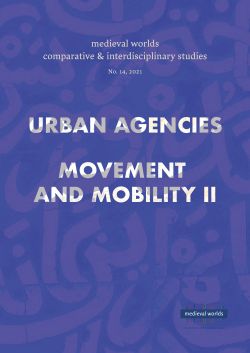 |
 |
Walter POHL – Andre GINGRICH (Eds.)
medieval worlds • no. 14 • 2021
Nicholas S. M. Matheou
S. 75 - 116 doi: 10.1553/medievalworlds_no14_2021s75
Verlag der Österreichischen Akademie der Wissenschaften doi: 10.1553/medievalworlds_no14_2021s75
Abstract:
This article addresses the themes of urban agency and state-centrism by analysing the agency of merchant capital and taxation in processes of urbanisation. The case study is the city of Ani, a now abandoned site in central south Caucasia straddling the Turkish-Armenian border, in the long thirteenth century c.1200-1350. This global-historical conjuncture is defined by the height of the medieval Commercial Revolution and its central Eurasian expression, the Silk Road. By 1200 Ani had developed as a thriving commercial centre for over two hundred years, with merchants coming to dominate the political economy in the city and its environs. By the mid-fourteenth century, however, this wealthy commercial class was no longer in evidence, with Ani’s urbanising process fundamentally transformed, beginning a rapid deurbanisation. Utilising contemporary theories of (de)urbanisation found in Ibn Khaldūn’s Muqaddima, this article first outlines Ani’s development up to 1200, focusing on the role of interregional and intercontinental commerce, and the urban elite’s rising dominance in landholding. Having established the mercantile and rentier regime of accumulation on which Ani’s development depended, we turn to the period of Zakarian-Mkhargrdzeli rule under the Georgian kingdom c.1200-1236, finding a wealthy commercial class hegemonic in the city’s political regime as well as the regime of accumulation. The final section, then, details the urban elite’s fortunes under Mongol Eurasian hegemony, and particularly the effects of drastically increased taxation in this political realisation of the medieval Silk Road. Ultimately the story of Ani in the global long thirteenth century forms a crucial case study for the combined agency of taxation and capital in urbanisation, both beneath and within the level of the state system, speaking to their contradictory symbiosis. At the same time, the city as a site of accumulation forms a crucial bridge in the Armenian merchant bourgeoisie’s trajectory from the medieval Commercial Revolution into the coalescence of capitalist modernity.
Armenia/Armenians, capitalism, cities, Commercial Revolution, Georgia/Georgians, epigraphy, Ilkhanate, merchants, Mongols, political economy, Silk Road, states, taxation, world systems Published Online:
2021/12/01 10:47:53 Object Identifier:
0xc1aa5576 0x003d080a
Rights:All rights reserved.For questions regarding copyright and copies please contact us by email.
medieval worlds provides a forum for comparative, interdisciplinary and transcultural studies of the Middle Ages. Its aim is to overcome disciplinary boundaries, regional limits and national research traditions in Medieval Studies, to open up new spaces for discussion, and to help developing global perspectives. We focus on the period from c. 400 to 1500 CE but do not stick to rigid periodization.
medieval worlds is open to submissions of broadly comparative studies and matters of global interest, whether in single articles, companion papers, smaller clusters, or special issues on a subject of global/comparative history. We particularly invite studies of wide-ranging connectivity or comparison between different world regions.
Apart from research articles, medieval worlds publishes ongoing debates and project and conference reports on comparative medieval research.
Urban Agencies: Reframing Anatolian and Caucasian Cities (13th-14th Centuries)
Guest Editors: Bruno de Nicola and Matthew Kinloch
Preface
Matthew Kinloch and Bruno de Nicola
Reframing Medieval Anatolia, Caucasia, and the Aegean: Narratives, States, and Cities
Matthew Kinloch
Urban Agency and the City Notables of Medieval Anatolia
A. C. S. Peacock
Cities and Imperial Authority in the Western Provinces of the Byzantine Empire, 12th-14th Centuries
Teresa Shawcross
A Conceptual Account of Market Morals that Resonated in Medieval Anatolia under Christian and Muslim Rule
İklil Selçuk
Merchant Capital, Taxation and Urbanisation. The City of Ani in the Global Long Thirteenth Century
Nicholas S. M. Matheou
Looking for Urban Agency in a City of Memorials: Tomb Towers of Late-Thirteenth-Century Ahlat
Oya Pancaroğlu
Urban Agency in the Borderlands: Turkmen Rulers and Administrative Elites in 13th-century Kastamonu
Bruno De Nicola
“These are the narratives of bygone years”: Conquest of a Fortress as a Source of Legitimacy
Dimitri Korobeinikov
Movement and Mobility in the Medieval Mediterranean:
Changing Perspectives from Late Antiquity to the Long-Twelfth Century, II
Guest Editors: Christopher Heath, Clemens Gantner and Edoardo Manarini
The Sicilian Tithe Business: State and Merchants in the Eleventh-Century Islamic Mediterranean
Lorenzo M. Bondioli
"Eager to Go to the Desert": Ambiguous Views on Ascetic Women’s Holy Travels in Late Antiquity
Andra Jugănaru
Where the Long Way Ends: Descriptions of the Mediterranean Sea and Holy Land and the Criticism of Crusading at the Court of Henry II of England (1154-1189)
Fabrizio de Falco
Individual Articles
"I am a virgin woman and a virgin woman’s child". Critical Plant Theory and the Maiden Mother Conceit in Early Medieval Riddles
Alaric Hall and Shamira A. Meghani
Latin and Hebrew Analogues to The Old Norse Leek Riddle
Alaric Hall
|




 Home
Home Print
Print
 References
References
 Share
Share
